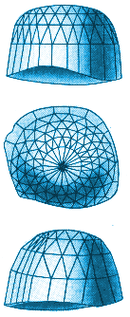Orlov (diamond)
 Copy of the Orlov diamond (it is turned upside-down in this photo) | |
| Weight | 189.62 carats (37.924 g) |
|---|---|
| Country of origin | India |
| Mine of origin | Kollur Mine |
| Owner | Kremlin Diamond Fund |
The Orlov (sometimes spelled Orloff) is a large diamond of Indian origin, currently displayed as a part of the collection of the Diamond Fund of the Moscow Kremlin. It is described as having the shape and proportions of half a chicken's egg. In 1774, it was encrusted into the Imperial Sceptre of Russian Empress Catherine the Great.
History
.jpg)
The diamond was found in the 17th century in Golkonda, India.[1] According to one legend, a French soldier who had deserted during the Carnatic wars in Srirangam disguised himself as a Hindu convert in order to steal it in 1747, when it served as the eye of a temple deity.[2][3]
The as yet unnamed stone passed from merchant to merchant, eventually appearing for sale in Amsterdam. Shaffrass, an Iranian millionaire who then owned the diamond,[4] found an eager buyer in Count Grigory Grigorievich Orlov.[5] The Count paid a purported 1,4 mln Dutch florins.[6]
Count Orlov had been romantically involved with Catherine the Great of Russia for many years, and he led the way in the dethronement of her husband in a coup d'état and the elevation of Catherine to power. Their relationship carried on for many years and produced an illegitimate child, but Catherine eventually forsook Count Orlov for Grigori Alexandrovich Potemkin. Count Orlov was said to have tried to rekindle their romance by offering her the diamond, as it is said he knew she had wished for it.[7] While he failed to regain her affections, Catherine did bestow many gifts upon Count Orlov; these gifts included the Marble Palace in Saint Petersburg. Catherine named the diamond after the Count, and she had her jeweller design a sceptre incorporating the diamond. Now known as the Imperial Sceptre, it was completed in 1774.
Actually, as the researchers prove, Catherine herself bought the diamond and only used Orlov's help with the deal and delivery, inventing the story about his generous present only to avoid criticism for spending the state's budget on jewelery. The Russian empress was very fond of diamonds, and she put them into fashion at her court and even called her personal stallion Diamond. In the 18th century, the sum of 1,4 mln florins was so immense that only the empress herself could afford it, and Count Orlov did not have such a fortune. Also, it is known that the precious stone was bought by instalments for 7 years, and when Count Orlov was going to pay the first payment, he discovered that it had already been paid from the empress's personal account.[8]
Description

A description was given by Eric Burton in 1986:
The sceptre is a burnished shaft in three sections set with eight rings of brilliant-cut diamonds, including some of about 30 carats (6 g) each and fifteen weighing about 14 carats (2.8 g) each. The Orlov is set at the top, with its domed top facing forward. Above it is a double-headed eagle with the Arms of Russia enameled on its breast.[9]
The Orlov is a rarity among historic diamonds, for it retains its original Indian rose-style cut (see diamond cut). Its colour is widely stated as white with a faint bluish-green tinge. Data released by the Kremlin give the Orlov's measurements as 32 millimetres x 35 millimetres x 21 millimetres, its weight being 189.62 carats (37.924 g). The weight is just an estimate – it has not formally been weighed in many years. Lord Twining's book A History of the Crown Jewels of Europe mentions how once, during a circa 1913 inspection of the crown jewels by the curator, the stone accidentally fell out of its sceptre. He weighed the stone, but did not write down its exact weight. He later said that it was about 190 carats (38 g), which corresponds to the measurement-based estimate.
References
- ↑ Streeter 1855, 105.
- ↑ Jaques 2007, p. 928.
- ↑ Erlich & Hausel 2002, p. 66.
- ↑ Dale Hoiberg, Indu Ramchandani (2008), Students' Britannica - India, Encyclopædia Britannica (UK) Ltd. p. 134. ISBN 0-85229-760-2
- ↑ Dixon, Simon (2010), Personality and Place in Russian Culture: Essays in Memory of Lindsey Hughes, Modern Humanities Research Assn. p. 171. ISBN 1-907322-03-5
- ↑ Streeter 1855, 108.
- ↑ Malecka, Anna " Did Orlov buy the Orlov ?", Gems and Jewellery, July 2014, vol. 23, no. 6, pp. 10–12.
- ↑ "Мистика и Бриллианты. Алмаз «Орлов»". Retrieved 2017-07-29.
- ↑ Burton, E. (1986). Legendary Gems or Gems That Made History, pp. 45–47. Chilton Book Company, Radnor, PA
Works cited
- Erlich, Edward; Hausel, W. Dan (2002). Diamond deposits: origin, exploration, and history of discovery. USA: Society of Mining, Metallurgy, and Exploration, Inc.(SME). ISBN 0-87335-213-0.
- Jaques, Tony (2007). Dictionary of battles and sieges: a guide to 8,500 battles from Antiquity through the Twenty-first Century, Volume 3. USA: Greenwood Publishing Group. ISBN 978-0-313-33539-6.
- Malecka, Anna (2014), "Did Orlov buy the Orlov ? ", Gems & Jewellery: The Gemmological Association of Great Britain, vol. 23 (6), July, pp. 10–12.
- Malecka, Anna (2016), The Great Mughal and the Orlov: One and the Same Diamond? The Journal of Gemmology, vol. 35, no. 1, 56-63.
- Shipley, Robert (1939). Famous Diamonds of the World, pp. 15–18. Gemological Institute of America, USA
- Twining, Lord Edward Francis (1960). A History of the Crown Jewels of Europe, B.T. Batsford Ltd., London, England.
- Streeter, Edwin W. (1882). The Great Diamonds Of The World: Their History And Romance. London. p. 103-115.
External links